2. 中国地质大学(北京)地质过程与矿产资源国家重点实验室,北京 100083;
3. 北京自然博物馆,北京 100050
2. State Key Laboratory of Geological Processes and Mineral Resources, China University of Geosciences, Beijing 100083, China;
3. Beijing Museum of Natural History, Beijing 100050, China
成矿物质来源和成矿过程是矿床学研究中最为关键的两个科学问题。传统的研究方法多利用H、C、O、S等稳定同位素来示踪成矿物质来源(Ripley, 1981; Shu et al., 2013; Deng et al., 2015; Ni et al., 2017; Chen et al., 2018; Wang et al., 2020),并反演成矿过程(Chen et al., 2017; Wang et al., 2018; 范宏瑞等, 2018),为理解矿床成因提供了重要依据。然而,这些元素并非直接成矿的元素,只能代表成矿流体和矿化剂的来源,无法直接示踪成矿金属的源区,制约了对金属矿床成因机制的深入理解。例如,在很多热液矿床中,H、O同位素显示成矿流体来自于岩浆水、大气水或盆地卤水的混合,C同位素则显示岩浆碳和围岩的混合,而S同位素则指示成矿的硫来自于岩浆。这些同位素均未能直接揭示成矿金属的源区特征。近年来,随着分析测试技术的进步,Fe、Cu、Zn等成矿金属元素的同位素分析取得重大突破,并被广泛利用于矿床学的相关研究,在示踪成矿物质来源(Mason et al., 2005; Mathur et al., 2009; Zhu et al., 2016; Deng et al., 2017)、反演成矿过程(Haest et al., 2009; Mathur et al., 2013)、揭示矿床成因(Wang et al., 2017; Zheng et al., 2019; Childress et al., 2020)等方面做出了突出贡献。其中,铁是地球上分布最广的主量元素之一,也是最重要的工业金属元素,含铁矿物广泛发育于各种类型的矿床中。因此,铁同位素分析对矿床学研究具有至关重要的意义。
铁为变价元素,以不同的价态(Fe0, Fe2+, Fe3+)广泛参与成岩、成矿过程,是重要的成矿元素。铁有54Fe(5.84%)、56Fe(91.76%)、57Fe(2.12%)和58Fe(0.28%)四个稳定同位素。在不同地质储库和地质过程中,铁同位素的组成和分馏具有明显差异(Fantle and DePaolo, 2004; Dauphas et al., 2007; Frost et al., 2007; Teng et al., 2008; Huang et al., 2011; 王跃和朱祥坤, 2012)。因此,铁同位素的研究是示踪成矿物质来源和反演成矿过程最直接最可靠的手段。目前,学者们利用铁同位素对BIF型和火山岩型Fe矿床(Johnson et al., 2003; Dauphas et al., 2004; Whitehouse and Fedo, 2007; 闫斌等, 2010; Günther et al., 2017; Song et al., 2021)、岩浆型Cu-Ni矿床(Wang et al., 2021)、斑岩型Cu-Mo(-Au) 矿床(Wawryk and Foden, 2017; Li et al., 2018; Zhang et al., 2021),矽卡岩型Fe-Cu(-Au)矿床(Wang et al., 2011, 2015; Zhu et al., 2016, 2020; Xue et al., 2021)、造山型Au矿床(Liu et al., 2021)和IOCG型矿床(Childress et al., 2020)的形成机理进行了有效的探讨,显示铁同位素体系在矿床学的研究中具有巨大潜力。
金厂河矿床是保山地块最具代表性的远端矽卡岩型多金属矿床之一,查明其成因机制对理解整个保山地块,乃至整个三江成矿省的区域成矿规律具有重要意义。前人对该矿床的成矿地质背景、矿床地质特征、成矿时代等方面进行了深入研究,并利用C、O、S等稳定同位素间接探讨了成矿物质来源(周荣等, 2008; 黄华等2014a, b; 李振焕等, 2020; 王基元等, 2021)。然而,对于成矿金属的来源尚缺乏直接证据。本文拟通过分析金厂河矽卡岩型多金属矿床不同成矿阶段含铁矿物的铁同位素组成,旨在更直接地揭示成矿物质来源并反演成矿过程,为深入理解保山地块远端矽卡岩型多金属矿床的成因机制提供有力证据。同时,本次研究也将积累可靠的矽卡岩型矿床中的铁同位素数据,拓展铁同位素体系在矿床学的应用。
1 区域地质保山地块位于我国西南三江特提斯构造带南段,东边以昌宁-孟连缝合带为界,西边以高黎贡山断裂为界,属滇缅泰马地块的北延分支(图 1a, b)。地块内出露各时代地层较为齐全,其基底为出露于潞西-龙陵地区的新元古界-寒武系公养河群,岩性主要为泥质板岩和浅变质砂岩,夹少量火山碎屑沉积,火山岩夹层的锆石U-Pb年龄约为499Ma(杨学俊等, 2012)。公养河群变质基底之上依次覆盖古生界浅海相碳酸盐岩台地沉积,中生界滨-浅海相碎屑沉积,古近系红色磨拉石粗碎屑堆积和第四系松散粗碎屑堆积。此外,由于保山地块位于构造演化活跃的特提斯复合造山带,造山作用引起的地壳抬升剥蚀和沉积间断导致下石炭统、中二叠统-下三叠统和上侏罗统-白垩系等地层缺失。同时,受多期增生-碰撞复合造山影响,保山地块内褶皱和断裂较为发育。主干断裂以澜沧江深大断裂和高黎贡山深大断裂为主,并发育瓦窑-云县断裂和柯街断裂等次级断裂。褶皱则以北部的保山-施甸复背斜和南部的永德-镇康复背斜为代表。

|
图 1 保山地块大地构造位置(a, 据Deng et al., 2014a, b, 2015, 2021; Deng and Wang, 2016, Wang et al., 2014)及区域地质简图(b, 据Liao et al., 2015; Chen et al., 2017, 2020) Fig. 1 Tectonic setting (a, after Deng et al., 2014a, b, 2015, 2021; Deng and Wang, 2016, Wang et al., 2014) and regional geological map (b, after Liao et al., 2015; Chen et al., 2017, 2020) of the Baoshan block |
保山地块内岩浆活动较为频繁,发育有早古生代、中二叠世、中三叠世、早白垩世和晚白垩世共五期中酸性侵入岩(图 1b)。其中,早古生代侵入岩以平河岩体为代表。该岩体出露面积约1200km2,以花岗岩和二长花岗岩为主,锆石U-Pb年龄为502~466Ma,为S型花岗岩,具高钾钙碱性、富集大离子亲石元素、亏损高场强元素等特征(董美玲等, 2012)。中二叠世侵入岩为碱性花岗岩,在木厂地区成群出现,以木厂岩体为代表,岩性主要为钠闪石石英碱正长岩、钠闪花岗岩和霓石花岗岩为主,锆石U-Pb年龄为266Ma(Ye et al., 2010)。中三叠世侵入岩主要发育于地块东南缘,以耿马S型花岗岩体为代表,锆石U-Pb年龄为232~230Ma,岩性为二长花岗岩,富集大离子亲石元素、亏损高场强元素(聂飞等, 2012)。早白垩世侵入岩零星分布于地块北部,以志本山岩体为代表。该岩体为一复式岩体,岩性包括黑云母花岗岩、二云母花岗岩和浅色花岗岩等,锆石U-Pb年龄为126.7±1.6Ma(陶琰等, 2010; Zhu et al., 2018)。晚白垩世侵入岩则以漕涧、柯街、薅坝地等小岩体为代表,多为S型花岗岩,锆石U-Pb年龄揭示其侵位时代为85~67Ma(廖世勇等, 2013; 禹丽等, 2014, 2015)。此外,保山地块还发育一期重要的基性-超基性岩浆活动,即晚石炭世-早二叠世卧牛寺组玄武岩,其锆石U-Pb年龄为310~280Ma(Liao et al., 2015; Liu et al., 2020)。
频繁的构造-岩浆活动导致保山地块发育多种类型的成矿作用,包括以大雪山Cu-Ni矿床为代表的岩浆型Cu-Ni成矿作用,以核桃坪Pb-Zn矿床、金厂河Zn-Pb-Fe-Cu矿床和芦子园Fe-Zn-Pb矿床为代表矽卡岩型Zn-Pb-Fe成矿作用,以黄家地Au矿床和黑牛凹Au矿床为代表的岩浆热液脉型Au成矿作用,以云龙Sn矿床为代表的热液脉型Sn成矿作用,以及以西邑Pb-Zn矿床、东山Pb-Zn矿床和勐兴Pb-Zn矿床为代表的低温热液型Zn-Pb-Ag成矿作用(图 1b)。其中,以大雪山矿床为代表的岩浆型Cu-Ni成矿作用发育于晚石炭世-早二叠世卧牛寺组溢流玄武岩中,系该期岩浆活动的产物(Wang et al., 2018)。
2 矿床地质金厂河Zn-Pb-Fe-Cu矿床是保山地块内最具代表性的隐伏矽卡岩型多金属矿床之一。矿区位于地块北部核桃坪背斜的右翼,北东向的木瓜树-朱石箐断裂和北西向的木瓜树-阿石寨断裂交汇于矿区东部,是控制金厂河矿区的主要断裂系统。矿区出露地层由老自新依次为寒武系核桃坪组大理岩化灰岩、钙质板岩和沙河厂组灰岩、粉砂岩,奥陶系施甸组、蒲缥组和仁和桥组砂岩,以及泥盆系向阳寺组灰岩(图 2)。其中,核桃坪组根据岩性差异可划分为三段:上段为大理岩化灰岩,厚约750m;中段为夹灰岩透镜体的钙质板岩,厚约260m;下段也为大理岩化灰岩,厚度大于500m(图 2)。核桃坪组中段的夹灰岩透镜体钙质板岩是金厂河矿床主要赋矿围岩。矿区未见中酸性岩浆岩出露,仅发育与矿化无关的晚三叠世至早二叠世的辉绿岩和辉长岩脉(黄华等, 2014b; Liao et al., 2015; Liu et al., 2020)。
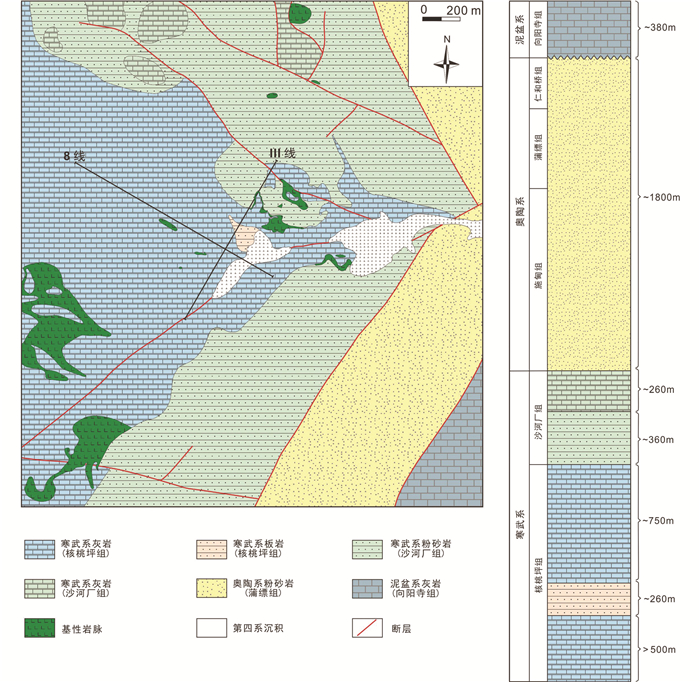
|
图 2 金厂河矽卡岩型多金属矿床地质简图(据黄华等, 2014a) Fig. 2 Geological sketch map of Jinchanghe skarn polymetallic deposit (after Huang et al., 2014a) |
受控于成矿热液的交代作用,矿区围岩热液蚀变明显,发育大量钙硅酸盐矿物,如石榴子石、辉石、黑柱石、角闪石、绿帘石和绿泥石等,且围岩蚀变呈现出明显的垂向分带性。从底部(海拔约1400m)至顶部(海拔约1850m),矿区核桃坪组碳酸盐岩围岩的蚀变类型依次为红棕色含绿帘石石榴子石矽卡岩、含阳起石黑柱石矽卡岩、含绿帘石黄绿色石榴子石矽卡岩、含辉石阳起石矽卡岩和含角岩夹层的大理岩(图 3a)。值得注意的是,金厂河矿床内发育的石榴子石多呈黄绿色,且均为中细粒结构,为典型的远端矽卡岩型矿床的特征(Meinert et al., 2005)。
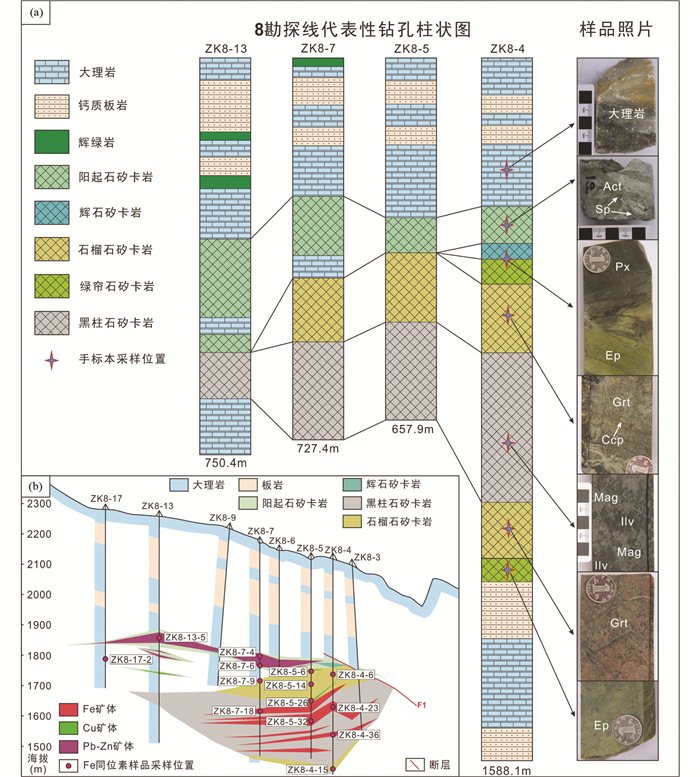
|
图 3 金厂河矽卡岩型多金属矿床8号勘探线钻孔岩性柱状图(a)及蚀变和矿化分带图(b)(据黄华等, 2014b) Grt-石榴子石;Px-辉石;Ilv-黑柱石;Mag-磁铁矿;Act-阳起石;Ep-绿帘石;Sp-闪锌矿;Ccp-黄铜矿 Fig. 3 Lithological column of drill holes (a) and alteration and mineralization zonation of No.8 exploration line (b) in Jinchanghe skarn polymetallic deposit (Huang et al., 2014b) Grt-garnet; Px-pyroxene; Ilv-ilvaite; Mag-magnetite; Act-actinolite; Ep-epidote; Sp-sphalerite; Ccp-chalcopyrite; |
与矽卡岩化的垂向分带相耦合,矿区的金属矿化也具有明显的垂向分带性。底部主要发育与黑柱石矽卡岩密切共生的Fe矿化,以磁铁矿为主;中部发育与石榴子石矽卡岩密切共生的Cu矿化,以黄铜矿和斑铜矿为主;顶部则发育与含辉石阳起石矽卡岩密切共生的Pb-Zn矿化,以闪锌矿、方铅矿为主,伴生少量黄铁矿,磁黄铁矿和黄铜矿等(图 3b)。截止目前,金厂河Fe-Cu-Pb-Zn矿床内共探明34个具有经济价值的隐伏矿体,均埋藏于地表以下261~732m,包括:9个铅锌矿体,厚0.32~29.38m,品位为2.37%~8.26%的Zn和0.29%~1.77%的Pb;17个铜矿体,厚0.49~26.59m,品位为0.57%~2.50%的Cu;8个铁矿体,厚0.80~74.01m,品位为17.60%~51.75%的Fe。矿体主要呈透镜体状和纺锤体状顺层展布,也可见大量脉状矿体穿层产出。矿石矿物主要为磁铁矿、黄铜矿、闪锌矿、方铅矿和斑铜矿;脉石矿物则主要发育石榴子石、辉石、黑柱石、阳起石、绿帘石、绿泥石、石英和方解石。
3 成矿阶段与矿物共生组合基于详实的矿区地质调查和精细的镜下显微观察,根据脉体穿切关系和矿物共生组合特征,将金厂河矿床的矽卡岩化和矿化划分为四个阶段(图 4),包括:(Ⅰ)成矿前阶段,矿物组合为石榴子石和辉石;(Ⅱ)氧化物成矿阶段,矿物组合为黑柱石、阳起石、磁铁矿和绿帘石;(Ⅲ)硫化物成矿阶段,矿物组合为黄铜矿、斑铜矿、闪锌矿、方铅矿、黄铁矿、磁黄铁矿等硫化物和石英与方解石;(Ⅳ)成矿后阶段,矿物组合为石英、方解石、绿泥石和褐铁矿。
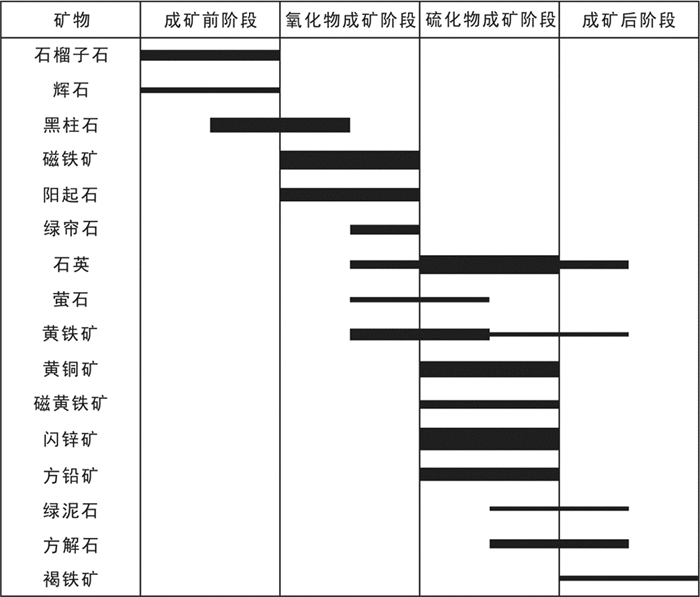
|
图 4 金厂河矽卡岩型多金属矿床矿物共生组合 Fig. 4 Mineral paragenesis of the Jinchanghe skarn polymetallic deposit |
成矿前阶段:主要以发育不含水的石榴子石和辉石等矽卡岩矿物为特征,系矽卡岩化的最早阶段。在本阶段,几乎无磁铁矿和硫化物的形成,表明成矿作用尚未开始。金厂河矿区的石榴子石主要发育于矽卡岩蚀变带的中部,多呈黄绿色,具中细粒结构(< 2mm),自形或半自形。石榴子石通常呈块状集合体产出,并被后期脉体(如黑柱石+石英脉)所穿切(图 5a)。此外,也有少量石榴子石产出于矽卡岩蚀变带的上部,与辉石共生,并同样被后期黑柱石脉穿切(图 5b)。BSE图像显示石榴子石颗粒的成分具有明显的环带变化(图 6a),可能代表了其在结晶过程中成矿流体的成分发生了显著的改变。局部石榴子石被褐铁矿交代,呈现出棕红色(图 6b)。相比石榴子石,金厂河矿床的辉石相对较少,主要产出于矽卡岩蚀变带的上部,多呈墨绿色,中细粒结构(< 3mm),自形或半自形产出(图 6c)。辉石常与石榴子石共生,形成矿物集合体,并被晚期脉体(如石英或阳起石脉)穿切(6d)。在部分样品中,可以观察到辉石被后期热液蚀变为角闪石,残余少量辉石并保留着原辉石的晶形(图 6e)。
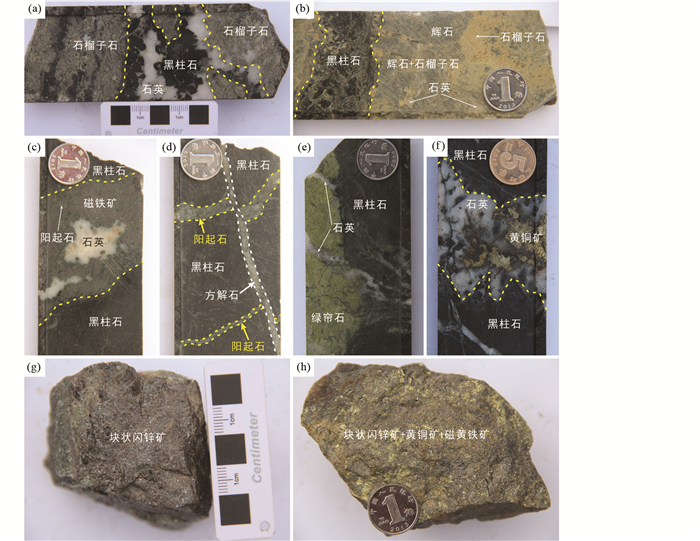
|
图 5 金厂河矽卡岩型多金属矿床代表性矽卡岩和矿石照片 (a)阳起石矽卡岩中的块状闪锌矿;(b)硫化物成矿阶段的含黄铜矿石英脉穿切成矿前阶段的辉石矽卡岩;(c)氧化物成矿阶段的黑柱石、磁铁矿和石英脉穿切成矿前阶段的石榴子石矽卡岩;(d)黄绿色石榴子石与辉石共生,局部被黑柱石交代,且均被后期石英脉穿切;(e)阳起石脉穿切黑柱石矽卡岩,且都被后期不含矿方解石脉穿切;(f)氧化物成矿阶段的黑柱石-磁铁矿脉穿切成矿前阶段的石榴子石矽卡岩,再被不含矿石英脉穿切;(g)辉石-阳起石矽卡岩中的含闪锌矿和方铅矿石英脉;(h)角岩中的浸染状黄铁矿,被成矿后阶段的不含矿方解石脉穿切 Fig. 5 Representative photos of skarn and ores in the Jinchanghe Zn-Pb-Fe-Cu deposit (a) massive sphalerite associated with actinolite skarn; (b) the pre-ore stage pyroxene skarn was cross-cut by a sulfide-ore stage chalcopyrite-quartz vein; (c) the pre-ore stage garnet skarn was cross-cut by an oxide-ore stage ilvaite-magnetite-quartz vein; (d) yellow-green garnet was associated with pyroxene, which was locally replaced by ilvaite, and both were cross-cut by a later quartz vein; (e) dark ilvaite skarn was cross-cut by actinolite vein. Both were cross-cut by a barren calcite vein; (f) the pre-ore stage garnet skarn was cross-cut by an oxide-ore stage ilvaite-magnetite vein, which also was cross-cut by a later barren quartz vein; (g) sphalerite-galena-quartz stockworks in pyroxene-actinolite skarn; (h) disseminated pyrite in hornfels, both cross-cut by post-ore stage barren calcite veins |
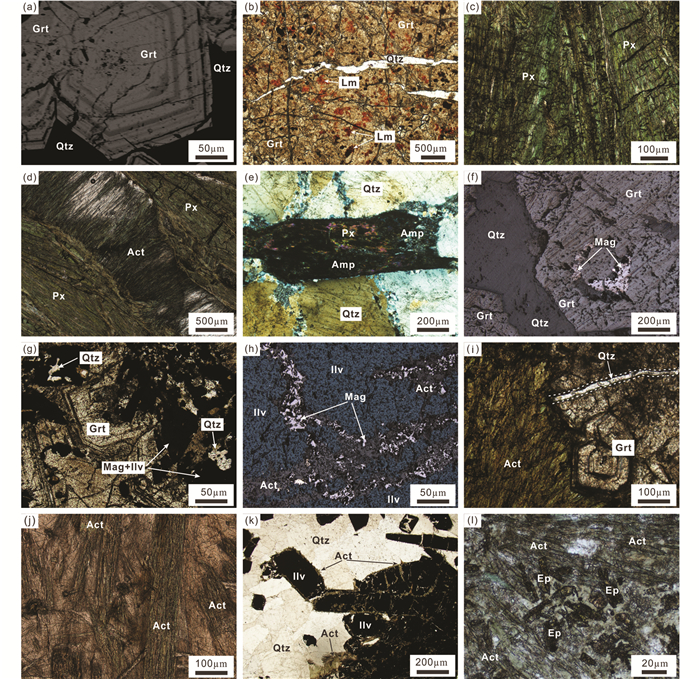
|
图 6 金厂河矽卡岩型多金属矿床成矿前阶段和氧化物成矿阶段代表性矿物显微照片 (a)具成分环带的石榴子石颗粒,边部被硫化物交代;(b)边部富钙铁榴石的石榴子石集合体;(c)墨绿色自形-半自形辉石颗粒;(d)阳起石脉穿切辉石矽卡岩;(e)自形的辉石颗粒被蚀变为角闪石;(f)石榴子石集合体被石英脉穿切和被磁铁矿交代;(g)石榴子石集合体被黑柱石和磁铁矿交代;(h)磁铁矿和阳起石充填于黑柱石的裂隙中;(i)石榴子石集合体被石英脉穿切,再一起被放射状阳起石交代;(j)毛发状阳起石集合体;(k)阳起石围绕着黑柱石颗粒生长;(l)绿帘石交代阳起石集合体. Amp-角闪石;Qtz-石英;Lm-褐铁矿 Fig. 6 Typical photomicrographs of pre-ore and oxide-ore stage in the Jinchanghe skarn polymetallic deposit (a) zonation of garnet grains showing a composition variation from core to rim. The rim was replaced by sulfides; (b) zonation of garnet aggregates displaying a andradite-rich rim; (c) euhedral to subhedral pyroxene crstals being dark green in color; (d) pyroxene aggregates were cross-cut by actinolite vein; (e) euhedral pyroxene grains were altered to be amphiboles; (f) garnet aggregates were cross-cut by quartz vein and replaced by magnetite; (g) garnet aggregates were overprinted by ilvaite and magnetite; (h) magnetite and actinolite filled the interstices among ilvaite; (i) garnet aggregates were cross-cut by a quartz vein. And both were overprinted by radial actinolite aggregates; (j) fibrous actinolite aggregates; (k) actinolite developed around ilvaite grains; (l) actinolite aggregates were overprinted by epidote. Amp-amphibole; Qtz-quartz; Lm-limonite |
氧化物成矿阶段:以出现大规模的Fe矿化(如磁铁矿),同时伴生大量的含水钙铁硅酸盐矿物(如黑柱石、绿帘石和阳起石等)为特征。磁铁矿是此阶段最重要的矿石矿物,代表了金厂河矿床的Fe成矿作用。磁铁矿多以细粒、半自形或他形颗粒呈致密块状或细脉状产出于矽卡岩蚀变带的下段。此外,矽卡岩蚀变带的中段和上段也可见少量磁铁矿,多以细粒浸染状产出。金厂河矿区的磁铁矿与黑柱石紧密共生,常呈集合体交代早期的石榴子石(图 6f, g)。也可见磁铁矿石英脉穿切黑柱石(图 5c),或磁铁矿充填于黑柱石的裂隙中(图 6h),表明磁铁矿晚于黑柱石形成。黑柱石是发育最多的脉石矿物,常呈自形的柱状颗粒形成集合体,主要产出于矽卡岩蚀变带的下段,与铁矿化紧密相关。黑柱石是一种典型的含水富铁硅酸盐矿物,常交代石榴子石等早期矿物(图 6g),同时也被阳起石、绿帘石、硫化物、石英和方解石等后期矿物穿切或交代(图 5d-f)。角闪石为本阶段另一种常见的脉石矿物,以阳起石为主,多呈毛发状或放射状集合体产出(图 6i, j)。矿区内常见角闪石交代早期的石榴子石(图 6i),或者围绕磁铁矿或黑柱石颗粒发育(图 6k),表明角闪石的形成不仅晚于石榴子石和辉石,同样也晚于黑柱石和磁铁矿。此外,局部还可见绿帘石交代角闪石(图 6l),指示氧化物成矿阶段的矿物发育顺序为黑柱石→磁铁矿→角闪石→绿帘石。
硫化物成矿阶段:以广泛发育Zn、Pb、Cu、Fe硫化物为特征,并伴生大量的石英、方解石和少量的绿泥石等脉石矿物(图 7a)。在金厂河矿区,硫化物多呈块状集合体产出于矽卡岩蚀变带的中上段(图 5g, h),也常见脉状的含硫化物石英方解石脉。本阶段的金属矿化作用主要包括以闪锌矿和方铅矿为主的Zn、Pb矿化和以黄铜矿和斑铜矿为主的Cu矿化。其中,闪锌矿和方铅矿主要发育于矽卡岩蚀变带的上段,交代早期的辉石和绿帘石等矿物(图 7b, c),或充填于辉石、石榴子石和黑柱石的裂隙中(图 7b, d, e)。闪锌矿多呈红色或红棕色,透明至半透明,常与方铅矿、黄铁矿和磁黄铁矿等形成不规则的矿物集合体(图 7f)。在矽卡岩蚀变带的中段,闪锌矿和方铅矿含量大大减少,主要发育黄铜矿和少量斑铜矿,表明Pb-Zn矿化减弱而Cu矿化增强。在此部位,黄铜矿与石榴子石紧密共生,并常见黄铜矿交代石榴子石颗粒,或充填于石榴子石的裂隙中。黄铁矿多呈自形或半自形颗粒产出,并被黄铜矿等硫化物包裹(图 7g),表明黄铁矿的形成可能早于黄铜矿等硫化物。此外,在矽卡岩蚀变带的下段也可见少量黄铁矿围绕磁铁矿集合体发育,很可能是本阶段强还原性流体还原磁铁矿而形成的(图 7h)。
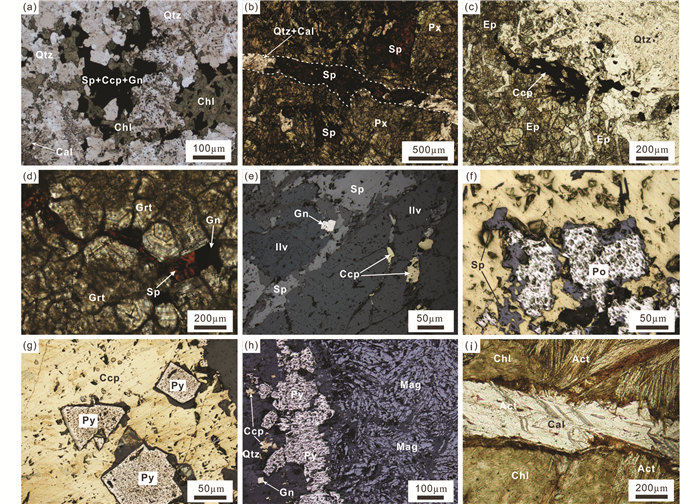
|
图 7 金厂河矽卡岩型多金属矿床硫化物成矿阶段及成矿后阶段矿物显微照片 (a)闪锌矿和绿泥石脉穿切萤石集合体;(b)硫化物成矿阶段的闪锌矿交代成矿前阶段的辉石;(c)硫化物成矿阶段的含闪锌矿石英脉穿切成矿前阶段的辉石;(d)硫化物成矿阶段的闪锌矿和方铅矿充填于成矿前阶段的石榴子石裂隙中;(e)硫化物成矿阶段的黄铜矿交代成矿前阶段的石榴子石,或充填于其裂隙中;(f)闪锌矿与磁黄铁矿和黄铜矿共生;(g)早期自形的黄铁矿与黄铜矿共生;(h)硫化物成矿阶段的黄铁矿围绕氧化物成矿阶段的磁铁矿集合体发育;(i)成矿后阶段不含矿方解石脉穿切阳起石-绿泥石集合体. Gn-方铅矿;Py-黄铁矿;Chl-绿泥石;Cal-方解石;Po-磁黄铁矿 Fig. 7 Typical photomicrographs of sulfide-ore and post-ore stage in the Jinchanghe skarn polymetallic deposit (a) fluorite aggregates were cross-cut by a sphalerite vein, associated with chlorite; (b) pre-ore stage pyroxene was rimmed or overprinted by sulfide-ore stage sphalerite veinlets; (c) pre-ore stage pyroxene was replaced or cross-cut by sphalerite + quartz veinlets; (d) sulfide-ore stage sphalerite and galena fills the fractures of the pre-ore stage garnet; (e) sulfide-ore stage chalcopyrite overprints the pre-ore stage garnet, or fills the interstices among them; (f) sphalerite developed associated with pyrrhotite and chalcopyrite; (g) early euhedral pyrite grains developed with chalcopyrite; (h) oxide-ore stage magnetite aggregates was rimmed by the sulfide-ore stage pyrite and quartz; (i) actinolite-chlorite aggregates were cross-cut by a post-ore stage barren calcite vein. Gn-galena; Py-pyrite; Chl-chlorite; Cal-calcite; Po-pyrrhotite |
成矿后阶段:以发育不含矿的石英和方解石脉为特征,代表矿石矿物已经基本完全沉淀结晶。本阶段常见不含矿的石英和方解石脉穿切早期形成的矿物集合体,如阳起石等(图 7i)。
4 样品采集和分析方法为了研究金厂河矿床的铁同位素组成及其地质意义,采集了不同成矿阶段的富铁矿物样品进行铁同位素分析,包括:成矿前阶段的石榴子石样品4件;氧化物成矿阶段的磁铁矿样品4件;硫化物成矿阶段的黄铁矿2件和黄铜矿3件;核桃坪组碳酸盐岩围岩中的黄铁矿1件。其中,成矿前阶段的4件石榴子石样品中有2件样品后期蚀变明显。样品的采样位置见图 3a。
样品的薄片、光片和探针片磨制,以及单矿物的挑选提纯均在廊坊地科勘探技术服务有限公司完成,并将挑选的单矿物粉碎并研磨至200目。铁同位素分析在中国地质大学(北京)非传统稳定同位素实验室完成。首先,根据不同矿物的铁含量计算实验所需的样品量,定量称取样品后置入Teflon溶样杯中,加入高纯度的浓HNO3溶解样品,然后转换为盐酸介质,再利用层析法分离Fe和其它元素。样品铁同位素组成的测定利用Therom-Finnigan公司生产的Neptune plus型多接收电感耦合等离子体质谱仪(MC-IPC-MS)完成,详细的化学提取分离步骤和分析测试设置见Liu et al.(2014)和He et al. (2015)。测试结果均以样品铁同位素比值相对于IRMM-014标样的同一同位素比值的千分偏差表示:

|
仪器长期测定56Fe的重现性和精度(2SD)高于±0.05‰(He et al., 2015)。分析标样BCR-2和BHVO-2的精度(2SD)分别为0.02‰和0.03‰。本次实验测试样品的精度(2SD)为0.04‰~0.09‰(表 1)。
|
|
表 1 金厂河矽卡岩型多金属矿床矿物和围岩铁同位素组成 Table 1 The iron isotopic compositions of minerals and wall rocks in Jinchanghe skarn polymetallic deposit |
金厂河矿床的成矿前阶段石榴子石、氧化物成矿阶段磁铁矿、硫化物成矿阶段黄铁矿和黄铜矿、碳酸盐岩围岩中的黄铁矿的铁同位素组成列于表 1。所有样品的δ56Fe和δ57Fe值呈线性相关(图 8),其δ56Fe=0.6933×δ57Fe+0.0053(R2=0.9970),与理论上的铁同位素平衡质量分馏曲线斜率基本一致,表明本次测试的金厂河矿床中不同成矿阶段矿物中铁同位素数据质量较高,结果是高度可信的。
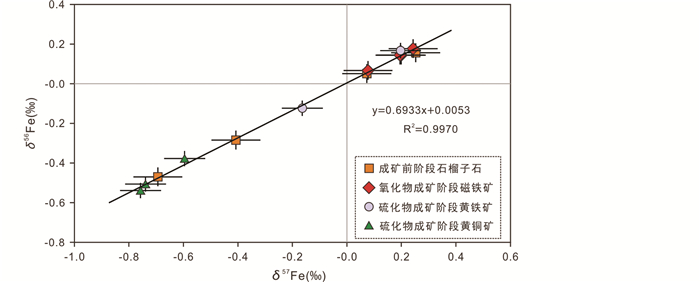
|
图 8 金厂河矽卡岩型多金属矿床不同成矿阶段含铁矿物之间的铁同位素分馏 Fig. 8 Plot of measured δ57Fe versus δ56Fe values of Fe-bearing minerals from different stages in Jinchanghe skarn polymetallic deposit |
成矿前阶段石榴子石的δ56Fe值为-0.47‰~0.16‰。其中,两件被后期热液蚀变的石榴子石样品具有较低的δ56Fe值,分别为-0.47‰和-0.29‰。而未蚀变的两件石榴子石样品的δ56Fe值相对较高,分别为0.05‰和0.16‰。氧化物成矿阶段的磁铁矿的δ56Fe值为0.07‰~0.18‰。硫化物成矿阶段的黄铁矿和黄铜矿的δ56Fe值分别为-0.12‰~0.17‰和-0.54‰~-0.38‰。而核桃坪组碳酸盐岩围岩中的浸染状黄铁矿的δ56Fe值为0.71‰。
6 讨论 6.1 影响矽卡岩成矿系统中Fe同位素组成的因素前人研究表明,铁同位素体系在研究岩石学、矿床学等地球科学问题方面具有巨大应用潜力(Welch et al., 2003; Wang et al., 2011; Cheng et al., 2015; He et al., 2017; 王跃和朱祥坤, 2012)。而查明影响铁同位素体系的变化规律及其控制因素,是利用铁同位素示踪物质来源和反演地质过程的基本前提。通常,矿床中矿物的铁同位素的组成主要受其物质源区铁同位素组成和成矿过程中Fe同位素分馏的影响。
在矽卡岩成矿系统中,成矿的金属铁可能的来源包括富铁的岩浆源区、围岩和盆地卤水等(Meinert et al., 2005; Wang et al., 2015; Zhu et al., 2016)。源自不同地质储库的铁,其铁同位素组成具有明显差异,是利用铁同位素示踪成矿物质源区的主要依据。同时,成矿过程中的铁同位素分馏也会导致成矿系统中不同位置,不同阶段铁同位素组成存在差异(Cheng et al., 2015; Zhu et al., 2016; Li et al., 2018)。Wang et al. (2011)与陈晓峰和朱祥坤(2011)分别对长江中下游的新桥和铜绿山矽卡岩型矿床开展了铁同位素研究,发现岩浆出溶的初始流体均相对富集铁的轻同位素。该研究结果与Heimann et al. (2008)的理论预测高度吻合。同时,铁作为变价元素,其价态对同位素分馏也存在显著影响。Johnson et al. (2002)和Welch et al. (2003)开展的铁同位素氧化还原平衡分馏实验显示,在常温下,高氧逸度的三价铁溶液的δ56Fe值比低氧逸度下的二价铁溶液高2.75‰~3.00‰,表明铁的重同位素相对富集于Fe3+中,而铁的轻同位素相对富集于Fe2+中。此外,在矽卡岩系统中,矿物的次生蚀变作用也十分普遍。Markl et al. (2006)通过研究Schwarzwald热液脉型矿床中含铁矿物的铁同位素组成,显示高温环境下原生菱铁矿被蚀变为赤铁矿和针铁矿,其δ56Fe值显著升高,由-1.36‰~-0.74‰升高至0.50‰~0.90‰。而在低温环境下原生菱铁矿被蚀变为针铁矿和赤铁矿,其δ56Fe值变为-1.10‰~-0.50‰,与原生菱铁矿(-1.36‰~-0.70‰)基本一致。同时,δ56Fe值为-0.30‰的原生硫化物经低温蚀变形成的两种铁的砷化物的δ56Fe值分别为-0.16‰和-0.24‰,基本保留了原生硫化物的铁同位素组成。以上研究表明,在矽卡岩等岩浆热液成矿系统中,流体出溶、流体演化过程中的氧化还原、以及高温次生蚀变等过程均会导致铁同位素的分馏机制发生改变,从而影响成矿系统中的铁同位素组成,而低温次生蚀变则基本不改变铁同位素组成。
6.2 金厂河矿床成矿过程中的Fe同位素分馏在岩浆热液系统中,铁同位素的分馏可以发生在流体从岩浆房出溶以及后期演化等多个过程中(Bilenker, 2015; Li et al., 2018; Zhang et al., 2021)。大量的研究表明,当流体从岩浆房出溶,形成的初始流体相对富集铁的轻同位素,并且,分异程度越高的火成岩,越相对富集铁的重同位素(Weyer et al., 2005; Heimann et al., 2008; Schoenberg et al., 2009; Zambardi et al., 2014; He et al., 2017)。当流体出溶后,其复杂的演化过程导致铁同位素在不同机制下发生分馏。因此,查明铁同位素在流体演化不同阶段的分馏机制,有利于反演成矿过程,为矿床学研究提供可靠依据。
在金厂河矿区,由于成矿相关岩体至今未被揭露,制约了对流体从岩浆房出溶这一过程中铁同位素分馏的研究,但是,多期次矽卡岩矿物的发育为探讨成矿流体演化过程中铁同位素的分馏提供了理想的研究对象。如表 1所示,成矿前阶段未被蚀变的石榴子石的δ56Fe值为0.05‰~0.16‰;氧化物成矿阶段磁铁矿的δ56Fe值为0.07‰~0.18‰;而硫化物成矿阶段的黄铁矿和黄铜矿的δ56Fe值分别为-0.12‰~0.17‰和-0.54‰~-0.38‰。整体呈现出随着成矿流体的演化,结晶矿物的δ56Fe值逐渐降低的趋势(图 9)。造成这种规律性变化的可能性有以下两种:(1)低δ56Fe值端元的持续混入;(2)成矿流体演化过程中铁同位素分馏导致结晶矿物相对富集铁的轻同位素。在矽卡岩系统中,成矿流体广泛与围岩相互作用,导致围岩中的组分大量混入。然而,在金厂河矿区,围岩中浸染状黄铁矿具有较高的δ56Fe值,为0.71‰,表明围岩富集铁的重同位素。因此,围岩中铁的混入可以排除。矿物流体包裹体和电子探针分析表明,金厂河矿床成矿前阶段具有高温度高氧逸度的特征,经氧化物成矿阶段向硫化物成矿阶段演化过程中,温度和氧逸度也随之降低(陈福川, 2018),表明温度和氧逸度的降低很可能是控制结晶矿物相对富集铁的轻同位素的关键因素。但是,从成矿前阶段向氧化物阶段演化的过程中,成矿流体温度降低明显(从约450℃降低至约270℃;陈福川, 2018),而结晶矿物的δ56Fe值基本不变,指示金厂河矽卡岩成矿系统中控制铁同位素分馏的关键因素是氧逸度而不是温度。在高氧逸度环境下,结晶富Fe3+的矿物,富集铁的重同位素;低氧逸度环境下,结晶富Fe2+的矿物,富集铁的轻同位素。

|
图 9 金厂河矽卡岩型多金属矿床不同成矿阶段矿物铁同位素组成及变化趋势 Fig. 9 Iron isotopic compositions and trend of Fe-bearing minerals from different stages in Jinchanghe skarn polymetallic deposit |
值得注意的是,两件后期经严重褐铁矿化蚀变的石榴子石样品具有相对低的δ56Fe值。这一现象与铁的重同位素倾向于进入Fe3+不符,很可能是由于石榴子石先经硫化物交代,然后硫化物再在低温环境下被表生蚀变成褐铁矿而导致的(Markl et al., 2006; 王跃和朱祥坤, 2012)。
6.3 Fe同位素示踪金厂河矿床成矿物质来源成矿物质来源是研究成矿作用最关键的科学问题之一,而铁同位素可以直接示踪成矿金属源区,是研究矿床成矿物质来源最直接最可靠的手段(Graham et al., 2004; Hofmann et al., 2009; Zhu et al., 2016; Zhang et al., 2021)。在金厂河矿床中,早期高氧逸度沉淀的石榴子石和磁铁矿富集铁的重同位素,而晚期低氧逸度沉淀的硫化物则显著富集铁的轻同位素,从而导致矽卡岩系统中铁同位素组成会随着成矿流体演化而变化。因此,早期矿物(如石榴子石)结晶时的成矿流体的铁同位素组成更接近原始出溶流体。此外,金厂河矿床中成矿前阶段石榴子石和氧化物成矿阶段磁铁矿的δ56Fe值基本一致,指示成矿前阶段至氧化物成矿阶段成矿流体的氧逸度变化较小。
如表 1所列,金厂河矿床成矿前阶段未蚀变石榴子石和氧化物成矿阶段磁铁矿的δ56Fe值分别为0.05‰~0.16‰和0.07‰~0.18‰,变化范围较窄,同位素组成均一,表明成矿流体中的铁为单一来源,且各阶段矿物的δ56Fe值显著低于碳酸盐岩围岩(0.71‰),而与花岗岩的δ56Fe值基本一致(图 10),表明成矿的铁很可能来自于隐伏的中酸性岩体。成矿期方解石的C、O同位素和硫化物的S同位素组成也与花岗质岩浆热液相似(黄华, 2014; 李振焕等, 2020),证明成矿流体和矿化剂元素也主要来源于岩浆。此外,根据磁铁矿与二价铁溶液之间的平衡系数计算公式:103lnαFe(Ⅱ)溶液-磁铁矿=-0.145×106/T2+0.10(温度T单位为K;Frierdich et al., 2014),参考陈福川(2018)关于金厂河矿床的流体包裹体研究结果,磁铁矿沉淀的平均温度约为270℃,在此温度下,103lnαFe(Ⅱ)溶液-磁铁矿=-0.39,指示初始成矿流体的铁同位素组成比磁铁矿轻0.39‰,计算获得的成矿流体的δ56Fe值为-0.32‰~-0.21‰,略低于全球花岗岩的δ56Fe值(0.007‰~0.36‰),符合前人研究所得的出溶流体的δ56Fe值低于母岩浆0.30‰~1.20‰这一结论(Wang et al., 2011),进一步表明铁来自于成矿相关岩体。
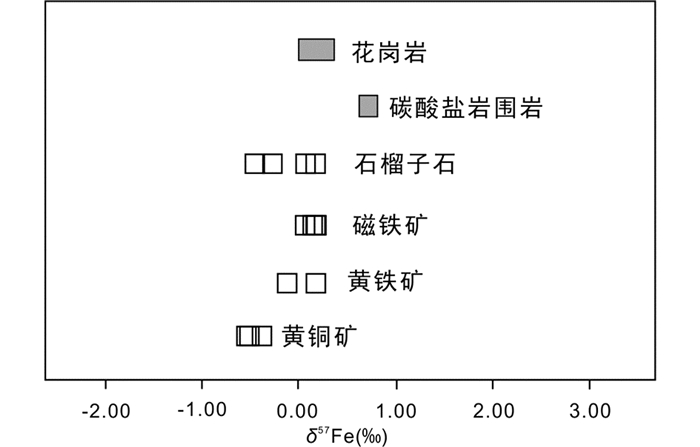
|
图 10 金厂河矽卡岩型多金属矿床不同成矿阶段矿物铁同位素组成与可能源区对比图 Fig. 10 Comparison of iron compositions of Fe-bearing minerals from different stages in Jinchanghe skarn polymetallic deposit and possible sources |
(1) 矽卡岩成矿系统中铁同位素受氧逸度控制明显,Fe3+富集铁的重同位素,Fe2+富集铁的轻同位素,而后期低温次生蚀变作用基本不导致明显的铁同位素分馏;
(2) 金厂河远端矽卡岩型多金属矿床中各阶段矿物的δ56Fe值均显著低于碳酸盐围岩,而接近全球花岗岩的δ56Fe值,指示成矿的铁主要来自于隐伏的与成矿相关的中酸性岩体。
致谢 本次研究的野外工作得到了云南黄金集团保山金厂河矿业有限公司工作人员的支持;实验室测试分析得到了中国地质大学(北京)非传统稳定同位素实验室工作人员的帮助;论文成文过程中得到了昆明理工大学徐荣博士的帮助;两位匿名审稿人和编辑部俞良军博士对本文的完善提供了宝贵的修改意见和建议;在此一并表示感谢。
Bilenker LD. 2015. Elucidating igneous and ore-forming processes with iron isotopes by using experimental and field-based methods. Ph. D. Dissertation. Michigan: University of Michigan
|
Chen FC, Deng J, Shu QH, Li GJ, Cui XL, Zhao F and Wang QF. 2017. Geology, fluid inclusion and stable isotopes (O, S) of the Hetaoping distal skarn Zn-Pb deposit, northern Baoshan block, SW China. Ore Geology Reviews, 90: 913-927 DOI:10.1016/j.oregeorev.2016.10.013
|
Chen FC. 2018. The study of Early Cretaceous skarn mineralization in Longyang ore concentration area, Baoshan Block, Sanjiang region, SW China. Ph. D. Dissertation. Beijing: China University of Geosciences (Beijing), 48-80 (in Chinese with English abstract)
|
Chen FC, Deng J, Wang QF, Li GJ, Shu QH, Yang CH, Liu JY and Xu R. 2018. The source and evolution of ore fluids in the Heiniuwa gold deposit, Baoshan block, Sanjiang region: Constraints from sulfide trace element, fluid inclusion and stable isotope studies. Ore Geology Reviews, 95: 725-745 DOI:10.1016/j.oregeorev.2018.03.013
|
Chen FC, Deng J, Wang QF, Huizenga JM, Li GJ and Gu YW. 2020. LA-ICP-MS trace element analysis of magnetite and pyrite from the Hetaoping Fe-Zn-Pb skarn deposit in Baoshan block, SW China: Implications for ore-forming processes. Ore Geology Reviews, 117: 103309 DOI:10.1016/j.oregeorev.2020.103309
|
Chen XF and Zhu XK. 2011. Studies on Fe and Cu isotopes of Tonglvshan skarn-type deposit. Acta Mineralogica Sinica, 32(Suppl.1): 1001-1003 (in Chinese)
|
Cheng YB, Mao JW, Zhu XK and Wang Y. 2015. Iron isotope fractionation during supergene weathering process and its application to constrain ore genesis in Gaosong deposit, Gejiu district, SW China. Gondwana Research, 27(3): 1283-1291 DOI:10.1016/j.gr.2013.12.006
|
Childress TM, Simon AC, Reich M, Barra F, Arce M, Lundstrom CC and Bindeman IN. 2020. Formation of the Mantoverde iron oxide-copper-gold (IOCG) deposit, Chile: Insights from Fe and O stable isotopes and comparisons with iron oxide-apatite (IOA) deposits. Mineralium Deposita, 55(7): 1489-1504 DOI:10.1007/s00126-019-00936-x
|
Dauphas N, van Zuilen M, Wadhwa M, Davis AM, Marty B and Janney PE. 2004. Clues from Fe isotope variations on the origin of Early Archean BIFs from Greenland. Science, 306(5704): 2077-2080 DOI:10.1126/science.1104639
|
Dauphas N, Cates NL, Mojzsis SJ and Busigny V. 2007. Identification of chemical sedimentary protoliths using iron isotopes in the >3750Ma Nuvvuagittuq supracrustal belt, Canada. Earth and Planetary Science Letters, 254(3-4): 358-376 DOI:10.1016/j.epsl.2006.11.042
|
Deng J, Wang QF, Li GJ and Santosh M. 2014a. Cenozoic tectono-magmatic and metallogenic processes in the Sanjiang region, southwestern China. Earth-Science Reviews, 138: 268-299 DOI:10.1016/j.earscirev.2014.05.015
|
Deng J, Wang QF, Li GJ, Li C and Wang CM. 2014b. Tethys tectonic evolution and its bearing on the distribution of important mineral deposits in the Sanjiang region, SW China. Gondwana Research, 26(2): 419-437 DOI:10.1016/j.gr.2013.08.002
|
Deng J, Liu XF, Wang QF and Pan RG. 2015. Origin of the Jiaodong-type Xinli gold deposit, Jiaodong Peninsula, China: Constraints from fluid inclusion and C-D-O-S-Sr isotope compositions. Ore Geology Reviews, 65: 674-686 DOI:10.1016/j.oregeorev.2014.04.018
|
Deng J and Wang QF. 2016. Gold mineralization in China: Metallogenic provinces, deposit types and tectonic framework. Gondwana Research, 36: 219-274
|
Deng J, Wang CM, Bagas L, Selvaraja V, Jeon H, Wu B and Yang LF. 2017. Insights into ore genesis of the Jinding Zn-Pb deposit, Yunnan Province, China: Evidence from Zn and in-situ S isotopes. Ore Geology Reviews, 90: 943-957 DOI:10.1016/j.oregeorev.2016.10.036
|
Deng J, Wang QF, Gao L, He WY, Yang ZY, Zhang SH, Chang LJ, Li GJ, Sun X and Zhou DQ. 2021. Differential crustal rotation and its control on giant ore clusters along the eastern margin of Tibet. Geology, 49(4): 428-432 DOI:10.1130/G47855.1
|
Dong ML, Dong GC, Mo XX, Zhu DC, Nie F, Xie XF, Wang X and Hu ZC. 2012. Geochronology and geochemistry of the Early Palaeozoic granitoids in Baoshan block, western Yunnan and their implications. Acta Petrologica Sinica, 28(5): 1453-1464 (in Chinese with English abstract)
|
Fan HR, Li XH, Zuo YB, Chen L, Liu S, Hu FF and Feng K. 2018. In-situ LA-(MC)-ICPMS and (Nano)SIMS trace elements and sulfur isotope analyses on sulfides and application to confine metallogenic process of ore deposit. Acta Petrologica Sinica, 34(12): 3479-3496 (in Chinese with English abstract)
|
Fantle MS and DePaolo DJ. 2004. Iron isotopic fractionation during continental weathering. Earth and Planetary Science Letters, 228(3-4): 547-562 DOI:10.1016/j.epsl.2004.10.013
|
Frierdich AJ, Beard BL, Scherer MM and Johnson CM. 2014. Determination of the Fe(Ⅱ)aq-magnetite equilibrium iron isotope fractionation factor using the three-isotope method and a multi-direction approach to equilibrium. Earth and Planetary Science Letters, 391: 77-86 DOI:10.1016/j.epsl.2014.01.032
|
Frost CD, von Blanckenburg F, Schoenberg R, Frost BR and Swapp SM. 2007. Preservation of Fe isotope heterogeneities during diagenesis and metamorphism of banded iron formation. Contributions to Mineralogy and Petrology, 153(2): 211-235 DOI:10.1007/s00410-006-0141-0
|
Graham S, Pearson N, Jackson S, Griffin W and O'Reilly SY. 2004. Tracing Cu and Fe from source to porphyry: In situ determination of Cu and Fe isotope ratios in sulfides from the Grasberg Cu-Au deposit. Chemical Geology, 207(3-4): 147-169 DOI:10.1016/j.chemgeo.2004.02.009
|
Günther T, Klemd R, Zhang X, Horn I and Weyer S. 2017. In-situ trace element and Fe-isotope studies on magnetite of the volcanic-hosted Zhibo and Chagangnuoer iron ore deposits in the Western Tianshan, NW China. Chemical Geology, 453: 111-127 DOI:10.1016/j.chemgeo.2017.02.001
|
Haest M, Muchez P, Petit JCJ and Vanhaecke F. 2009. Cu isotope ratio variations in the Dikulushi Cu-Ag deposit, DRC: Of primary origin or induced by supergene reworking?. Economic Geology, 104(7): 1055-1064 DOI:10.2113/econgeo.104.7.1055
|
He YS, Ke S, Teng FZ, Wang TT, Wu HJ, Lu YH and Li SG. 2015. High-precision iron isotope analysis of geological reference materials by high-resolution MC-ICP-MS. Geostandards and Geoanalytical Research, 39(3): 341-356 DOI:10.1111/j.1751-908X.2014.00304.x
|
He YS, Wu HJ, Ke S, Liu SA and Wang Q. 2017. Iron isotopic compositions of adakitic and non-adakitic granitic magmas: Magma compositional control and subtle residual garnet effect. Geochimica et Cosmochimica Acta, 203: 89-102 DOI:10.1016/j.gca.2017.01.005
|
Heimann A, Beard BL and Johnson CM. 2008. The role of volatile exsolution and sub-solidus fluid/rock interactions in producing high 56Fe/54Fe ratios in siliceous igneous rocks. Geochimica et Cosmochimica Acta, 72(17): 4379-4396 DOI:10.1016/j.gca.2008.06.009
|
Hofmann A, Bekker A, Rouxel O, Rumble D and Master S. 2009. Multiple sulphur and iron isotope composition of detrital pyrite in Archaean sedimentary rocks: A new tool for provenance analysis. Earth and Planetary Science Letters, 286(3-4): 436-445 DOI:10.1016/j.epsl.2009.07.008
|
Huang F, Zhang ZF, Lundstrom CC and Zhi XC. 2011. Iron and magnesium isotopic compositions of peridotite xenoliths from eastern China. Geochimica et Cosmochimica Acta, 75(12): 3318-3334 DOI:10.1016/j.gca.2011.03.036
|
Huang H. 2014. The research on geological characteristics and metallogenesis of the Jinchanghe Fe-Cu-Pb-Zn polymetallic deposit, Yunnan Province. Master Degree Thesis. Beijing: China University of Geosciences (Beijing), 52-55 (in Chinese with English abstract)
|
Huang H, Zhang CQ, Zhou YM, Liu B, Xie YF, Dong YT, Yang CH and Dong WW. 2014a. Skarn mineralogy and zoning model of the Jinchanghe copper-zinc-iron polymetallic deposit in Yunnan Province. Acta Petrologica et Mineralogica, 33(1): 127-148 (in Chinese with English abstract)
|
Huang H, Zhang CQ, Zhou YM, Xie HF, Liu B, Xie YF, Dong YT, Yang CH and Dong WW. 2014b. Rb-Sr isochron age of Jinchanghe Fe-Cu-Pb-Zn polymetallic deposit in Yunnan Province and its geological significance. Mineral Deposits, 33(1): 123-136 (in Chinese with English abstract)
|
Johnson CM, Skulan JL, Beard BL, Sun H, Nealson KH and Braterman PS. 2002. Isotopic fractionation between Fe (Ⅲ) and Fe (Ⅱ) in aqueous solutions. Earth and Planetary Science Letters, 195(1-2): 141-153 DOI:10.1016/S0012-821X(01)00581-7
|
Johnson CM, Beard BL, Beukes NJ, Klein C and O'Leary JM. 2003. Ancient geochemical cycling in the earth as inferred from Fe isotope studies of banded iron formations from the Transvaal Craton. Contributions to Mineralogy and Petrology, 144(5): 523-547 DOI:10.1007/s00410-002-0418-x
|
Li JX, Qin KZ, Li GM, Evans NJ, Huang F and Zhao JX. 2018. Iron isotope fractionation during magmatic-hydrothermal evolution: A case study from the Duolong porphyry Cu-Au deposit. Tibet. Geochimica et Cosmochimica Acta, 238: 1-15 DOI:10.1016/j.gca.2018.07.008
|
Li ZH, Li WC, Liu XL, Luo Y, Shen Y, Liu SH and Chen JH. 2020. Metallogenic mechanism of Jinchanghe Fe-Cu-Pb-Zn polymetallic deposit in Baoshan block, western Yunnan: Evidence from fluid inclusions and S-Pb isotope. Mineral Deposits, 39(6): 995-1014 (in Chinese with English abstract)
|
Liao SY, Wang DB, Tang Y, Yin FG, Sun ZM and Sun J. 2013. LA-ICP-MS U-Pb age of two-mica granite in the Yunlong tin-tungsten metallogenic belt in Three River region and its geological implications. Acta Petrologica et Mineralogica, 32(4): 450-462 (in Chinese with English abstract)
|
Liao SY, Wang DB, Tang Y, Yin FG, Cao SN, Wang LQ, Wang BD and Sun ZM. 2015. Late Paleozoic Woniusi basaltic province from Sibumasu terrane: Implications for the breakup of eastern Gondwana's northern margin. GSA Bulletin, 127(9-10): 1313-1330 DOI:10.1130/B31210.1
|
Liu CH, Liu JJ, Carranza EJM, Wang JP, Zhai DG, Zhang FF, Wang YH and Liu ZJ. 2021. Iron and magnesium isotope systematics from the Shuangwang gold deposit in the Qinling Orogen, central China. Ore Geology Reviews, 134: 104123 DOI:10.1016/j.oregeorev.2021.104123
|
Liu JY, Wang QF, Deng J, Li CS, Li GJ and Ripley EM. 2020. 280~310Ma rift-related basaltic magmatism in northern Baoshan, SW China: Implications for Gondwana reconstruction and mineral exploration. Gondwana Research, 77: 1-18 DOI:10.1016/j.gr.2019.07.004
|
Liu SA, Li DD, Li SG, Teng FZ, Ke S, He YS and Lu YH. 2014. High-precision copper and iron isotope analysis of igneous rock standards by MC-ICP-MS. Journal of Analytical Atomic Spectrometry, 29(1): 122-133 DOI:10.1039/C3JA50232E
|
Markl G, von Blanckenburg F and Wagner T. 2006. Iron isotope fractionation during hydrothermal ore deposition and alteration. Geochimica et Cosmochimica Acta, 70(12): 3011-3030 DOI:10.1016/j.gca.2006.02.028
|
Mason TFD, Weiss DJ, Chapman JB, Wilkinson JJ, Tessalina SG, Spiro B, Horstwood MSA, Spratt J and Coles BJ. 2005. Zn and Cu isotopic variability in the Alexandrinka volcanic-hosted massive sulphide (VHMS) ore deposit, Urals, Russia. Chemical Geology, 221(3-4): 170-187 DOI:10.1016/j.chemgeo.2005.04.011
|
Mathur R, Titley S, Barra F, Brantley S, Wilson M, Phillips A, Munizaga F, Maksaev V, Vervoort J and Hart G. 2009. Exploration potential of Cu isotope fractionation in porphyry copper deposits. Journal of Geochemical Exploration, 102(1): 1-6 DOI:10.1016/j.gexplo.2008.09.004
|
Mathur R, Munk L, Nguyen M, Gregory M, Annell H and Lang J. 2013. Modern and paleofluid pathways revealed by Cu isotope compositions in surface waters and ores of the Pebble porphyry Cu-Au-Mo deposit, Alaska. Economic Geology, 108(3): 529-541 DOI:10.2113/econgeo.108.3.529
|
Meinert LD, Dipple GM and Nicolescu S. 2005. World skarn deposits. In: Hedenquist JW, Thompson JFH, Goldfarb RJ and Richards JP (eds. ). One Hundredth Anniversary Volume. Littleton: Society of Economic Geologists
|
Ni P, Wang GG, Cai YT, Zhu XT, Yuan HX, Huang B, Ding JY and Chen H. 2017. Genesis of the Late Jurassic Shizitou Mo deposit, South China: Evidences from fluid inclusion, H-O isotope and Re-Os geochronology. Ore Geology Reviews, 81: 871-883 DOI:10.1016/j.oregeorev.2016.08.013
|
Nie F, Dong GC, Mo XX, Zhu DC, Dong ML and Wang X. 2012. Geochemistry, zircon U-Pb chronology of the Triassic granites in the Changning-Menglian suture zone and their implications. Acta Petrologica Sinica, 28(5): 1465-1476 (in Chinese with English abstract)
|
Ripley EM. 1981. Sulfur isotopic studies of the Dunka road Cu-Ni deposit, Duluth Complex, Minnesota. Economic Geology, 76(3): 610-620 DOI:10.2113/gsecongeo.76.3.610
|
Schoenberg R, Marks MAW, Schuessler JA, von Blanckenburg F and Markl G. 2009. Fe isotope systematics of coexisting amphibole and pyroxene in the alkaline igneous rock suite of the Ilímaussaq Complex, South Greenland. Chemical Geology, 258(1-2): 65-77 DOI:10.1016/j.chemgeo.2008.06.023
|
Shu QH, Lai Y, Sun Y, Wang C and Meng S. 2013. Ore genesis and hydrothermal evolution of the Baiyinnuo'er zinc-lead skarn deposit, Northeast China: Evidence from isotopes (S, Pb) and fluid inclusions. Economic Geology, 108(4): 835-860 DOI:10.2113/econgeo.108.4.835
|
Song Z, Li HM, Li LX, Ding JH and Meng J. 2021. Iron isotopes and trace element compositions of magnetite from the submarine volcanic-hosted iron deposits in East Tianshan, NW China: New insights into the mineralization processes. Journal of Earth Science, 32(1): 219-234 DOI:10.1007/s12583-020-1060-0
|
Tao Y, Hu RZ, Zhu FL, Ma YS, Ye L and Cheng ZT. 2010. Ore-forming age and the geodynamic background of the Hetanping lead-zinc deposit in Baoshan, Yunnan. Acta Petrologica Sinica, 26(6): 1760-1772 (in Chinese with English abstract)
|
Teng FZ, Dauphas N and Helz RT. 2008. Iron isotope fractionation during magmatic differentiation in Kilauea Iki Lava Lake. Science, 320(5883): 1620-1622 DOI:10.1126/science.1157166
|
Wang JY, Yang CH, Fu J, Zhang WW, Xie J and Li JB. 2021. Metallogenic models and prospecting criteria for the Jinchanghe Au-Cu polymetallic ore-concentration area in western Yunnan. Geology and Exploration, 57(2): 254-268 (in Chinese with English abstract)
|
Wang PY, Niu YL, Sun P, Wang XH, Guo PY, Gong HM, Duan M, Shen FY, Shi YN, Xue S, Chen YH and Shan L. 2021. Iron isotope compositions of coexisting sulfide and silicate minerals in Sudbury-type ores from the Jinchuan Ni-Cu sulfide deposit: A perspective on possible core-mantle iron isotope fractionation. Minerals, 11(5): 464 DOI:10.3390/min11050464
|
Wang QF, Deng J, Li CS, Li GJ, Yu L and Qiao L. 2014. The boundary between the Simao and Yangtze blocks and their locations in Gondwana and Rodinia: Constraints from detrital and inherited zircons. Gondwana Research, 26(2): 438-448 DOI:10.1016/j.gr.2013.10.002
|
Wang QF, Deng J, Li GJ, Liu JY, Li CS and Ripley EM. 2018. Geochronological, petrological, and geochemical studies of the Daxueshan magmatic Ni-Cu sulfide deposit in the Tethyan Orogenic Belt, Southwest China. Economic Geology, 113(6): 1307-1332 DOI:10.5382/econgeo.2018.4593
|
Wang QF, Zhao HS, Groves DI, Deng J, Zhang QW and Xue SC. 2020. The Jurassic Danba hypozonal orogenic gold deposit, western China: Indirect derivation from fertile mantle lithosphere metasomatized during Neoproterozoic subduction. Mineralium Deposita, 55(2): 309-324 DOI:10.1007/s00126-019-00928-x
|
Wang Y, Zhu XK, Mao JW, Li ZH and Cheng YB. 2011. Iron isotope fractionation during skarn-type metallogeny: A case study of Xinqiao Cu-S-Fe-Au deposit in the Middle-Lower Yangtze Valley. Ore Geology Reviews, 43(1): 194-202 DOI:10.1016/j.oregeorev.2010.12.004
|
Wang Y and Zhu XK. 2012. Fe isotope systematics and its implications in ore deposit geology. Acta Petrologica Sinica, 28(11): 3638-3654 (in Chinese with English abstract)
|
Wang Y, Zhu XK and Cheng YB. 2015. Fe isotope behaviours during sulfide-dominated skarn-type mineralisation. Journal of Asian Earth Sciences, 103: 374-392 DOI:10.1016/j.jseaes.2014.11.005
|
Wang YH, Zhang FF and Li BC. 2017. Genesis of the Yandong porphyry Cu deposit in eastern Tianshan, NW China: Evidence from geology, fluid inclusions and isotope systematics. Ore Geology Reviews, 86: 280-296 DOI:10.1016/j.oregeorev.2017.02.020
|
Wawryk CM and Foden JD. 2017. Iron-isotope systematics from the Batu Hijau Cu-Au deposit, Sumbawa, Indonesia. Chemical Geology, 466: 159-172 DOI:10.1016/j.chemgeo.2017.06.004
|
Welch SA, Beard BL, Johnson CM and Braterman PS. 2003. Kinetic and equilibrium Fe isotope fractionation between aqueous Fe(Ⅱ) and Fe(Ⅲ). Geochimica et Cosmochimica Acta, 67(22): 4231-4250 DOI:10.1016/S0016-7037(03)00266-7
|
Weyer S, Anbar AD, Brey GP, Münker C, Mezger K and Woodland AB. 2005. Iron isotope fractionation during planetary differentiation. Earth and Planetary Science Letters, 240(2): 251-264 DOI:10.1016/j.epsl.2005.09.023
|
Whitehouse MJ and Fedo CM. 2007. Microscale heterogeneity of Fe isotopes in >3. 71Ga banded iron formation from the Isua Greenstone Belt, southwest Greenland. Geology, 35(8): 719-722
|
Xue S, Niu YL, Chen YH, Shi YN, Xia BY, Wang PY, Gong HM, Wang XH and Duan M. 2021. Iron isotope fractionation during skarn Cu-Fe mineralization. Minerals, 11(5): 444 DOI:10.3390/min11050444
|
Yan B, Zhu XK, Tang SH and Zhu MY. 2010. Fe isotopic characteristics of the Neoproterozoic BIF in Guangxi Province and its implications. Acta Geologica Sinica, 84(7): 1080-1086 (in Chinese with English abstract)
|
Yang XJ, Jia XC, Xiong CL, Bai XZ, Huang BX, Luo G and Yang CB. 2012. LA-ICP-MS zircon U-Pb age of metamorphic basic volcanic rock in Gongyanghe Group of southern Gaoligong Mountain, western Yunnan Province, and its geological significance. Geological Bulletin of China, 31(2-3): 264-276 (in Chinese with English abstract)
|
Ye L, Gao W, Cheng ZT, Yang YL and Tao Y. 2010. LA-ICP-MS zircon U-Pb geochronology and petrology of the Muchang alkali granite, Zhenkang County, western Yunnan Province, China. Acta Geologica Sinica, 84(6): 1488-1499 DOI:10.1111/j.1755-6724.2010.00343.x
|
Yu L, Li GJ, Wang QF and Liu XF. 2014. Petrogenesis and tectonic significance of the Late Cretaceous magmatism in the northern part of the Baoshan block: Constraints from bulk geochemistry, zircon U-Pb geochronology and Hf isotopic compositions. Acta Petrologica Sinica, 30(9): 2709-2724 (in Chinese with English abstract)
|
Yu L, Wang QF, Li GJ and Gao L. 2015. Geochemistry, zircon U-Pb geochronology of granitic pegmatites from Caojian area in the northern Baoshan block, and their geological significance. Acta Petrologica Sinica, 31(11): 3281-3296 (in Chinese with English abstract)
|
Zambardi T, Lundstrom CC, Li XX and McCurry M. 2014. Fe and Si isotope variations at Cedar Butte volcano: Insight into magmatic differentiation. Earth and Planetary Science Letters, 405: 169-179 DOI:10.1016/j.epsl.2014.08.020
|
Zhang L, Qiu KF, Hou ZL, Pirajno F, Shivute E and Cai YW. 2021. Fluid-rock reactions of the Triassic Taiyangshan porphyry Cu-Mo deposit (West Qinling, China) constrained by QEMSCAN and iron isotope. Ore Geology Reviews, 132: 104068 DOI:10.1016/j.oregeorev.2021.104068
|
Zheng YC, Liu SA, Wu CD, Griffin WL, Li ZQ, Xu B, Yang ZM, Hou ZQ and O'Reilly SY. 2019. Cu isotopes reveal initial Cu enrichment in sources of giant porphyry deposits in a collisional setting. Geology, 47(2): 135-138
|
Zhou R, Chen J, Lü YZ and Dong WW. 2008. The large scale blind multimetallic ore deposit of Jinchanghe, Baoshan. Yunnan Geology, 27(2): 189-196 (in Chinese with English abstract)
|
Zhu B, Zhang HF, Zhao XM and He YS. 2016. Iron isotope fractionation during skarn-type alteration: Implications for metal source in the Han-Xing iron skarn deposit. Ore Geology Reviews, 74: 139-150
|
Zhu B, Zhang HF, Santosh M, Su BX, Zhang PF, Han CM and He YS. 2020. Iron isotopes constrain the metal sources of skarn deposits: A case study from the Han-Xing Fe Deposit, China. Minerals, 10(11): 951
|
Zhu RZ, Lai SC, Qin JF, Zhao SW and Santosh M. 2018. Strongly peraluminous fractionated S-type granites in the Baoshan Block, SW China: Implications for two-stage melting of fertile continental materials following the closure of Bangong-Nujiang Tethys. Lithos, 316-137: 178-198
|
陈福川. 2018. 西南三江保山地块珑阳矿集区早白垩世矽卡岩矿床成矿作用研究. 博士学位论文. 北京: 中国地质大学(北京), 48-80
|
陈晓峰, 朱祥坤. 2011. 铜绿山夕卡岩型铜铁矿床Fe、Cu同位素研究. 矿物学报, 32(增1): 1001-1003. |
董美玲, 董国臣, 莫宣学, 朱弟成, 聂飞, 谢许峰, 王霞, 胡兆初. 2012. 滇西保山地块早古生代花岗岩类的年代学、地球化学及意义. 岩石学报, 28(5): 1453-1464. |
范宏瑞, 李兴辉, 左亚彬, 陈蕾, 刘尚, 胡芳芳, 冯凯. 2018. LA-(MC)-ICPMS和(Nano)SIMS硫化物微量元素和硫同位素原位分析与矿床形成的精细过程. 岩石学报, 34(12): 3479-3496. |
黄华. 2014. 云南金厂河铁铜铅锌多金属矿床地质特征及成矿作用研究. 硕士学位论文. 北京: 中国地质大学(北京), 52-55
|
黄华, 张长青, 周云满, 刘博, 谢永富, 董云涛, 杨春海, 董文伟. 2014a. 云南金厂河铁铜铅锌多金属矿床矽卡岩矿物学特征及蚀变分带. 岩石矿物学杂志, 33(1): 127-148. |
黄华, 张长青, 周云满, 谢华锋, 刘博, 谢永富, 董云涛, 杨春海, 董文伟. 2014b. 云南保山金厂河铁铜铅锌多金属矿床Rb-Sr等时线测年及其地质意义. 矿床地质, 33(1): 123-136. |
李振焕, 李文昌, 刘学龙, 罗应, 申颖, 刘思晗, 陈建航. 2020. 滇西保山地块金厂河铁铜铅锌多金属矿床成矿机制——基于流体包裹体和硫、铅同位素证据. 矿床地质, 39(6): 995-1014. |
廖世勇, 王冬兵, 唐渊, 尹福光, 孙志明, 孙洁. 2013. "三江"云龙锡(钨)成矿带晚白垩世二云母花岗岩LA-ICP-MS锆石U-Pb定年及其地质意义. 岩石矿物学杂志, 32(4): 450-462. |
聂飞, 董国臣, 莫宣学, 朱弟成, 董美玲, 王霞. 2012. 滇西昌宁-孟连带三叠纪花岗岩地球化学、年代学及其意义. 岩石学报, 28(5): 1465-1476. |
陶琰, 胡瑞忠, 朱飞霖, 马言胜, 叶霖, 程增涛. 2010. 云南保山核桃坪铅锌矿成矿年龄及动力学背景分析. 岩石学报, 26(6): 1760-1772. |
王基元, 杨春海, 符俊, 张卫文, 谢俊, 李加斌. 2021. 滇西金厂河金铜多金属矿集区成矿模式与综合找矿模型. 地质与勘探, 57(2): 254-268. |
王跃, 朱祥坤. 2012. 铁同位素体系及其在矿床学中的应用. 岩石学报, 28(11): 3638-3654. |
闫斌, 朱祥坤, 唐索寒, 朱茂炎. 2010. 广西新元古代BIF的铁同位素特征及其地质意义. 地质学报, 84(7): 1080-1086. |
杨学俊, 贾小川, 熊昌利, 白宪洲, 黄柏鑫, 罗改, 杨朝碧. 2012. 滇西高黎贡山南段公养河群变质基性火山岩LA-ICP-MS锆石U-Pb年龄及其地质意义. 地质通报, 31(2-3): 264-276. |
禹丽, 李龚健, 王庆飞, 刘学飞. 2014. 保山地块北部晚白垩世岩浆岩成因及其构造指示: 全岩地球化学、锆石U-Pb年代学和Hf同位素制约. 岩石学报, 30(9): 2709-2724. |
禹丽, 王庆飞, 李龚健, 高磊. 2015. 保山地块漕涧花岗伟晶岩地球化学、锆石U-Pb年代学及其地质意义. 岩石学报, 31(11): 3281-3296. |
周荣, 陈均, 吕永增, 董文伟. 2008. 保山金厂河大型铜铁多金属隐伏矿床. 云南地质, 27(2): 189-196. |
 2022, Vol. 38
2022, Vol. 38

